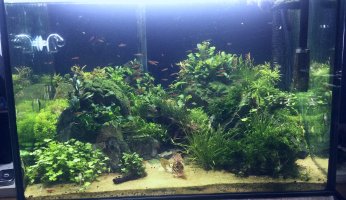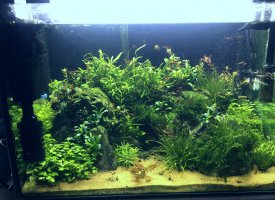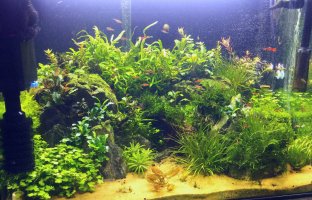Hi Clive,
Interesting...

But I'm a tad confused now, because what you describe above very much sounds like a form of competition to me. In this case, you describe algae solely as a parasitic grow form that likes to use the plant as a growing medium to attach to? But, then I should not have written "We" but "I" don't know if this competition is about nutrients or if it has more of an allelopathic nature. My belief tends more that it is more about allelopathy with developing a better immune system against a parasitic predator. I'm not sure if you kinda confirm that my belief is correct that nutrition plays a minor role.
Thus if Mice were parasites lurking in the dark waiting to attack unhealthy Elephants then I definitively see a competition here. Only not competing for food, the Elephant would be the food or food and or living space provider.
I can't see any absurdity in this interpretation.
Anyway, isn't all this a competition for living space but simply not for nutrition? And in your interpretation, healthier plant leaves provide less living space for alga to grow and therefore alga goes latently present. Which actually sounds very plausible.
Hi Marcel,
Well, really, we want to avoid getting bogged down with semantics in order to better understand what's going on in the tank. If we follow that path then we'll end up defining everything as a competition and will lose all sense of what the point is. We are well aware what the expression "competition" is referring to within this context. I'm referring to the general and pervasive myth in this hobby that there is some kind of competition going on specifically for nutrients between plants and algae. This then leads to the false idea that nutrients in the water are bad and that somehow, plants have the ability to remove nutrients from the water faster than algae can get to them and in so doing can starve algae out of existence. This leads to the idea that nutrients in general are bad and that the purpose of plants is to "mop up" this nutrient spillage in order to avoid algal blooms. You know this pervasive and long standing philosophy all stems from the one basic premise that nutrients cause algae and that nutrients are bad in general. We've been fighting this for years, so that any time someone uses the expression "competition" it reinforces and in the minds of beginners, validates these false concepts. This is the reason it is absurdity - because it is one false concept built on another.
Do you imagine that if elephants and mice are in the same location with a limited food supply, that there is any competition between the two? If the food supply is limited, which of the two will die of starvation first? This is the situation we have in the tank. Nutrients are food and we determine whether the supply of nutrients are limited or unlimited. When we limit the supply the plants, who require orders of magnitude greater food will always be the first to starve. Algae will never starve. It is virtually impossible to starve algae out of existence and that is why the false doctrine of "competition" between plants and algae is absurd.
So we should use this word cautiously because that is not the relationship between the two. As I have described, the relationship is predatory, however you want to describe it. It is this relationship within the confines of the tank that determines the outcome in any tank. If plants are not present in the tank then there is no relationship and the behavior of algae is completely different. The relationships are environment specific. This is why we make so many mistakes, because we read about relationships in one ecosystem and automatically decide that the same relationship exists in the tank.
In the article you reference the complex relationships between all the organisms is different than it is in our tanks. Our tanks is not a pelagic zone. It is an artificially created ecosystem with specific relationships developed in this box only. Some behaviors are the same, but the overall system cannot possibly the same.
In some ecosystems, unnatural levels of nutrients upset the balance in that system and yes, nutrients are a bad thing. In some systems, nutrient cause algae, but not in our system. We can study and learn from the behavior of algae but we should not automatically transcribe all that we observe in those systems into our system.
But what confuses me again, the 2 low-energy aquariums I'm referring to both also grow algae but they don't really attack the plants and attach to the substrate and hardscape. The filamentous one of what I think is a Clado sp. and if iI let it grow it grows from the rocks and the strains will eventually intertwine with the plants and mosses but it attaches to very few plant leaves. In the end, and if I don't remove it it will grow a thick mat cover, shade and suffocate the plant below it.
Yes, because the plants are healthy and they can resist the attacks. So for example, the method of attack is to afix themselves to a static surface, however, healthy plants have a growing and dynamic surface. They produce waxes and proteins that slough off and algae have less of a chance to affix themselves to these dynamic surfaces. So there are defense mechanisms healthy plants have to evade algae. Rocks are inanimate and are a static surface, so algae can affix themselves to any hardscape. There is not much we can do about that other than to mechanically remove them.
1 tank also grows BBA and it's the same thing plant leaves are BBA-free but the wood is covered with it and I find tuffs of it growing on the substrate. In these cases adding CO² would have 0 effects on fighting this alga since it grows from the hardscape? Am I correct to assume if I would add CO² it would not only favour the plants but also favour this alga growth and make it worse. And manual removal would be the only remedy?
This is another environment specific case in which we have to take into account how healthy the plants are, how much light there is, the diurnal and nocturnal movement of the gases and so forth. We cannot jump to the conclusion that throwing CO2 at a tank automatically will rid the tank of BBA because BBA love CO2 as well. How we implement CO2 and how the plants respond to the addition of CO2 will determine the outcome. BBA and all Red Algae in general are tenacious so once established they will not simply go away. They would have to be forcibly evicted via chemical and mechanical means and then a new relationship can be established between plants and BBA within the new CO2 environment.
This is the problem we have because our concepts regarding algae are false. Algae are not an "infection". They are often the dominant species and there is a
behavior which is established from their
relationship to other organisms in the system.
Cheers,






